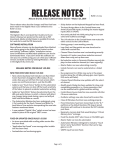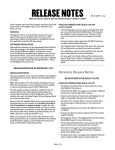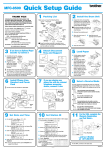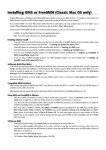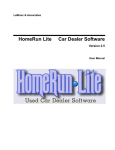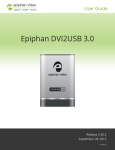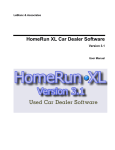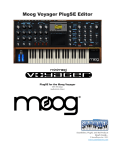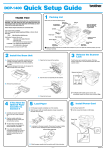Download Mackie X.200 Owner`s manual
Transcript
RELEASE NOTES Mackie Digital X Bus X.200 Software Update • May 4, 2005 These release notes describe changes and fixes that have been made in the Digital X Bus X.200 software since Build 1.01.023. MANUALS The Digital X Bus X.200 Quick-Start Guide and X.200 Owner's Manual are posted on the web site as PDF downloads. Adobe Acrobat Reader is available from Adobe’s web site to read the PDF documents. SOFTWARE INSTALLATION New software releases can be downloaded from Mackie’s web site by going to the Digital X Bus Product section and clicking “Software Update.” Installation instructions for Windows and Macintosh platforms can also be downloaded there. If you don't know the software version you are currently using, you can check your software version and build number by clicking Windows > About in the Digital X Bus menu bar. RELEASE NOTES FOR BUILD 1.01.027 SYSTEM FIXES SINCE BUILD 1.01.023 • Additional testing and fixes were made to the console’s virtual memory usage and management. This addresses the “Virtual Memory Error” messages that were being reported to appear on the screen(s) during operation. Even though this was a fix reported in Build 1.01.023, it was discovered again and required this additional fix to be implemented immediately. These virtual memory fixes address long-term use of the console between re-boots (over 70-80 hrs) as well as heavy use of the automation system. • A large number of session files created on both current and older versions of the X.200 software were used to fix a session recall/opening issue. All session files should now open correctly, regardless of the software build on which they were originally saved/ stored. This fix was implemented in response to some issues encountered with a similar fix that went into Build 1.01.023. • Specific console freezes associated with either writing or reading automation data have been fixed. This includes an intermittent freeze that occurred when writing automation from the control surface, but with the Mix Editor window open. As a result, the overall stability of the automation system has been improved dramatically. • If switched to 176.4 kHz or 192 kHz sampling rate, the console now alerts the user that there are fewer inputs to work with to accommodate the higher sampling rate. Specifically, the console automatically “shuts off” card slots 1-4 and marks those slots in the Build 1.01.027 I/O Configuration Panel as “Disabled.” Users who want to run the console at 176.4 kHz or 192 kHz will need to install their I/O Cards into slots 5-8 and will get a total of 32 channels in and out of the console, plus use of the Mix Out Card. The console will also disable inputs and outputs 1-32 from all software assignment pulldown menus so there is no confusion as to how the console operates at 192kHz. • All console automation support for the MIDI Layer has been removed because that layer is intended only to provide control for a DAW. You use the MIDI Layer of the X.200 to automate your DAW and not the console itself. Any automated moves that appear on that layer are a direct result of reading automated events that have been written (or are being written) to the DAW. This greatly simplifies the automation system of the console and better optimizes the automation functionality to the controls of the console itself, and not the DAW. • When changing the DAW Emulation Mode of the X.200, the MIDI Layer now re-initializes itself to refresh the communication between the console and your Mac/PC. This enhances the ability to use the MIDI Layer to control different audio programs without having to re-boot the console. This also counteracts some crashing that was resulting from loading DAW applications with the console connected. Additional measures were taken to improve the overall active sensing protocol of the MIDI Layer to further stabilize interactivity with a connected DAW. FIXED OR UPDATED SINCE BUILD 1.01.023 • An issue with soloing and un-soloing grouped channels along with a group master has been fixed. • The “Launch Executable (.exe)…” selection in the File Menu now launches pointers/links (.lnk files) to target executables as well as the executables themselves. • The “Faders To Tape” feature has been removed because of redundancy. Users can activate Fader Swap with “Level to Tape” enabled in the V-Strip to perform the exact same function. • Channel Read and Write status are no longer stored along with Snapshots. This was done to prevent accidental over-writing of automation data when recalling Snapshots. • All Write Assign buttons are now disabled when “Stop” is pressed on the transport. This prevents the accidental overwriting of automation events. With the Auto Write feature enabled (added in build 1.01.023), it is not necessary to keep write-enabling channels for each automation pass. Page 1 of 6 • The MIDI Layer has been removed from the console Snapshot parameters, such that Snapshots will only store and recall parameters of the console itself. The reason is that all DAWs can recall the settings of a particular session file, which in turn saves the positions of any controls on a connected control surface. Therefore Snapshots that include the MIDI Layer controls are unnecessary and redundant. • The “Launch Executable (.exe)…” option from the File Menu now runs the Universal Audio “.reg” license files associated with the UAD-1 Card. This enables UAD-1 enthusiasts to authorize any desired UAD plug-in license(s) for their X.200. • Audio now routes and passes correctly at 176.4 kHz and 192 kHz sampling rates. • The Automation Window can now be assigned as a Macro button command. • An issue that prevented the re-opening of some Windows after being closed has been fixed. • MIDI Layer fixes: – The MIDI Layer now initializes after Logic starts up. – The REW and FF commands now work correctly with Logic. – All controls and messages for 24 channels on the console are now showing up and acting correctly; this includes the V-Pots, the LED rings around the pots, channel names, etc. – The Write Assign buttons now act as track arming commands for the entire MIDI Layer; eventually, this command will change over to the Rec Assign button, but these Write Assign buttons can be used in the meantime. – Issues related to using the Cycle Mode feature of the MIDI Layer with Logic have been fixed. – Some “sticky button” LEDs associated with the MIDI Layer have been fixed. – Zoom Keys with the ALT and OPT modifier commands are now functioning properly. – Jog function on the HUI Layer has been fixed. – SHIFT+Play now functions as “Pause” command with Logic. – Channel Select as Touch command now working with Logic. – SHIFT+V-Select Mute command now working with Logic. Previous Release Notes RELEASE NOTES FOR BUILD 1.01.023 NEW FEATURES SINCE BUILD 1.01.020 • New colored Auxiliary level indicators on Main Mixer Screen have been changed to reflect status of aux sends. Now you can tell from the main screen which auxes are on/off, and pre/post….just like the d8b. • Added a new “Touch Sense” button to the automation system such that you can shut off the touch sensitivity of the faders to prevent accidental automation writing. • Added an “Auto Write” feature based primarily on the d8b auto write feature, in which a channel will detect any changes being made during a pass, and will put itself into Write Mode as a result. • The Automation Window has been redesigned, using V-Pot controls for the Touch Timeout and Write Flyback Return Time and also incorporating the new auto features mentioned above. • A new updated “Digital X Bus” splash screen has been added in place of the original “DXB” screen. FIXED OR UPDATED SINCE BUILD 1.01.020 • An issue associated with recalling older session files has been fixed. • “Application Not Found” error message after installation has been fixed. • Footswitches are functioning again. • Sticky button on the Keyboard/Keypad has been fixed. • The Input Assign Menu in the Control Room now shows all possible inputs, including the master digital inputs (AES or S/PDIF). • Aux sends patched into third party plug-ins are now saved and recalled accordingly. • The L/R selection in the Control Room now mutes the other sources to the Control Room. • Soloing groups is now working correctly. • Loop Start and Stop points are now stored and recalled with session files. • Channel Phase function now is automating correctly. • Dynamics VU meter now shows reduction amount down from unity, not up from zero. • Red reduction meter in Dynamics Window now only displays to show reduction amount (as it was originally). • Master faders are now automating correctly. • Linked channels can now be automated as a linked pair. • Bus assignment to L/R Mix now sums in the proper location along the L/R Mix pathway (pre-insert points, DSP, mute, and fader). Page 2 of 6 • Channel Preset Window now updates with the selected channel. • Modify Levels Dialog has been updated to show only compatible parameters, i.e., those parameters that can be modified with a global variation setting. • Control Room Source Selection now overrides all other CR source selections. • Communication with supported USB MIDI Interfaces has been dramatically improved. • The “Double Select” Shortcut that opens the Channel EQ and Dynamics section(s) has been re-enabled. • The calibration reference levels points in the Control Room Setup Window can be customized. • Oscillator settings now also stored with session files. • An issue with the attack setting of the channel compressor filter that created a “doubling” or a perceived delay with heavily compressed audio signals has been fixed. • Preset Directories have been moved back to the “D:/” partition as the default location; VST plug-in preset directories will continue to be where the VST installer puts them. RELEASE NOTES FOR BUILD 1.01.018 • Close All Windows function now working properly. • Repaired a memory leak that would display a “Virtual Memory Error” message. • Fixed the double-SHIFT select issue on the MIDI Layer. • Master Fader can now be automated. • Automation Window redesigned to include a “Touch Sense” and a “Auto Write” function that can be toggled on or off. • SMPTE input has been fixed. • The Mackie Final Mix VST has been added as a standard Digital X Bus plug-in. • STOP and PLAY MMC messages are no longer inhibited by the time code setting of the console. • Dynamics (Compressor/Gate) now will display the settings in the graphic display even if disabled. • Mic input trim encoder label is now consistent with actual input gain setting shown in the numerical reader. • Engaging talkback now activates the DIM for the Control Room. RELEASE NOTES FOR OS INSTALLER 1.1.04 INSTALLATION NOTES The main addition in this new OS Installer is the addition of Windows Service Pack 2 (SP2) to the Embedded OS of the mixer. Note: Please refer to the “OS Installer Installation Instructions” for instructions on how to perform this OS update. It must be performed using a USB CD ROM drive. This OS update provides many fixes related to the operation of the mixer with external USB peripherals, such as MIDI interfaces, USB CD ROM drives, etc. This installer also puts the latest Digital X Bus software (build 1.01.020) into the mixer. Because this OS Installer offers some major operational enhancements to the console, it is necessary to perform this OS Installation to update to build 1.01.020. You will notice that we have not posted build 1.01.020 as a separate download for exactly this reason. We will follow up this release with more software updates/builds, but all will be based on using OS Installer 1.1.04. Make sure you back up all session files, presets, or any other personal files to an external USB Flash drive before performing this update, as it will wipe the entire hard drive and rebuild the operating system. FIXED OR UPDATED SINCE BUILD 1.01.018 or OS 1.00.007 FIXED OR UPDATED SINCE BUILD 1.01.017 • Frequency labels have been added to the Channel EQ Graphic Display. • The playback timer in the Digital Performer Emulation Mode (MIDI Layer) is now functioning. • The hardware SCRUB button now activates the MIDI Layer Scrub function, along with the transport. • The correct messages are now being displayed on channels 17-24 of the Digital Performer Emulation Mode of the MIDI Layer. • The latency of return messages from Digital Performer when using the MIDI Layer has been improved. • All surround monitoring labels in the various assignment menus and Control Room output assignments are now consistent with each other. • The labeling for the Stereo Delay plug-in Delay setting is now in milliseconds (ms). • Cue Sends 1 and 2 have ancillary “Aux 9/10” and “Aux 11/12” labels in the Aux Window. • SIG LED and channel meter in the Digital Performer Emulation Mode of the MIDI Layer are now active. • You can now assign plug-ins across channels in Digital Performer using the Digital X Bus MIDI Layer. • All Channel and DSP preset dialog buttons (found in each of the Preset Windows) are now functioning properly. • The File Manager can now read and display files that are on an attached USB CD ROM drive. This includes the ability to read and launch any “Setup.exe” files common to almost all third party plug-in installer CDs. • Korean translations for the Digital X Bus software have been added to the supported language list in the Setup Window. Page 3 of 6 RELEASE NOTES FOR BUILD 1.01.017 • The “Launch 3rd Party Installer” in the File Menu has been re-named “Launch Executible (.exe)” for clarity. NEW FEATURES SINCE BUILD 1.0.095 • New Stereo Linking feature for all Auxiliary Sends such that any aux send on the console can be a mono send or part of a stereo pair. • New “Clear Plug-in Automation” selection in the Edit Menu. • Implementation of SHIFT, CTRL, and ALT modifiers on MCU (Mackie Control Universal) Layer. • New multi-lingual support has been added as an option in the Setup Window (Windows>Setup>General) for the following languages: ◊ Chinese ◊ Portuguese ◊ Spanish ◊ French • SIG LEDs have been removed on the HUI Layer (meters remain active). • Snapshots now recall all VST parameters. • Opening/Closing session files with VST plug-ins has been dramatically stabilized. • A new boot-up dialog now appears during the boot process to confirm to the user the console is booting. • The Calibration reference points in the Control Room can now be customized to your liking. • Session files now recall linked channels. • Resetting DSP on one linked channel now is applied across the linked pair. • Decimal point entry issue in the Virtual Keypad has been fixed. RELEASE NOTES FOR BUILD 1.0.095 FIXED OR UPDATED SINCE BUILD 1.0.095 • Improvements to switching Auto Modes for all channels on HUI Layer, by holding down the Auto Mode button on-screen and using the hardware SELECT buttons on the channel(s). • Improvements to accessing inserts for all channels on HUI Layer, by holding down the Insert button onscreen and using the hardware SELECT buttons on the channel(s). • Transport on the MCU/HUI Layer has been separated from that layer and can now be used as the DAW transport from any layer (with the “Include Transport” checkbox checked). • Addition of the DSP EDIT/ASSIGN view for editing plug-ins on HUI Layer; this section acts exactly the same way as the VFD plug-in editor on the original HUI controller. • The Active Sensing protocol of the MIDI Layer when used in HUI Mode has been dramatically improved. • All Mix Out Card labels in I/O Configuration Window have been corrected. • Output Assignments in the Control Room, Phones, and Talkback have been re-organized. FIXED OR UPDATED SINCE BUILD 1.0.092 The primary change in this release is the implementation of a new three-point touch screen calibration algorithm, which is intended to increase the Digital X Bus’ overall touch sensitivity on both screens. Specifically, this new calibration routine improves the accuracy of the touch controls along the screen edges and in the screen corners considerably. Also, it is now possible to calibrate one display at a time. Therefore, if you find that one screen seems to be reacting better or more accurately than the other, then you can choose to calibrate only that screen and leave the first one alone (or vice versa). You can go to Windows > Setup > General to see the new calibration controls, or perform either of the following shortcuts: CTRL+ALT+SHIFT+Macro #1 = Calibrates the left screen CTRL+ALT+SHIFT+Macro #2 = Calibrates the right screen CTRL+ALT+SHIFT+Macro #3 = Sets both screens to the factory default • Delay of talkback microphone input signal to phones or channel output has been decreased by a factor of 4x. • Session files not saving and recalling VST plug-in patches and settings has been fixed. RELEASE NOTES FOR BUILD 1.0.092 FIXED OR UPDATED SINCE BUILD 1.0.090 • Additional protection code has been added to increase overall system stability and operation, especially with opening/closing session files that have VST plug-ins loaded. • “Adjust Channel Delay” function is now calculating correctly across multiple channels and instances, even with a negative offset. • Floating Insert menus now showing the same output names as I/O Panel. • Improvements made to the “Follow Selected Channel” feature in the Mix Editor. • Level Balance pot in the Control Room between Near Field and Main has been re-labeled as “Near/Main Balance.” • Overall improvements to the Control Surface Layer (MIDI Button) such as metering, transport activity, general MIDI communication, and the controller “profiles” as recognized by the computer. Page 4 of 6 • New “3rd Party Installer” function from the File Menu now launches any “shortcut” link to an executable (.lnk files). This is for running plug-in authorizer apps that may be installed to the internal hard drive along with the plug-ins. • MIDI Map feature now has separate, user-selectable MIDI port assignment. • Drivers for the MIDIMAN MIDISPORT USB MIDI Interfaces in now included with the Operating System. USB MIDI Interfaces now supported and not needing any additional driver installation: • Touching any of the four EQ nodes now activates that corresponding bandfilter. • Footswitches 1 and 2 are now active. – USB MidiSport 1x1 – USB MidiSport 2x2 – USB MidiSport 2x4 – USB MidiSport 4x4 • Auto-Scrolling in Mix Editor now functioning to specification. • I/O panel graphic for Digital I/O Card now matches silkscreen. • Digital Performer overlay text correction – “Save” is now “Slave.” • EQ/Dynamics Reset Commands carries through a linked pair. Other USB MIDI Interface drivers can be installed (such as MOTU, Edirol, and ESI interfaces), but the ones in this list are supported without additional drivers required. • A new DXB OS Image (.iso file), as well as detailed instructions of how to use it, is now available for download from the Digital X Bus web site. The OS Image file should only be used in order to re-format the internal hard drive, or re-load the Operating System as well as the build of Digital X Bus software that is available at the time of the OS Image creation. The current OS Image file is v1.0.006, and it also has DXB v1.0.092 bundled with it. NOTE: Please read the instructions before downloading and using the OS Image. It requires a very specific process and it must be followed exactly or it will not function properly. You need to back up all sessions, presets, plug-in installers, and anything else you may have saved to your internal hard drive. You can download and create a CD using this OS Image from either a Mac or PC. If you have any questions about using the OS Image file, please contact the Mackie Technical Support Team at 800.898.3211 (toll free in the USA and Canada) or 425.487.4333 from outside the USA. • EQ Graphic display scaling/measurement now matches value of potentiometer. • Implementation of new “Software Installer” feature that runs any executable (.exe) file either attached via USB (CD or Flash drives) or from the internal hard drive. RELEASE NOTES FOR BUILD 1.0.088 INSTALLATION NOTES This update is a two-part installation procedure that includes a software update and a system update. It is very important that these updates be installed in the appropriate order. First, go to Install Packages in the dXb File Menu and install the software update to v1.0.088. Second, return to Install Packages and install System Update 1.0.01. The dXb will reboot upon completion of the updates. FIXED OR UPDATED SINCE BUILD 1.0.085 • Fixed — Selecting channels in the Mix Editor is not reflected in the hardware. • Fixed — Snapshot enumeration. • Fixed — Phones volume are Post C/R volume. • Fixed — Must toggle MIDI port/Sync settings to get MMC/MTC to work. • Fixed — Waves C1 plug-ins show up in Setup Dialog. RELEASE NOTES FOR BUILD 1.0.090 • Fixed — Digital Trim not linked. • Fixed — Aux Pre/Post not automating. FIXED OR UPDATED SINCE BUILD 1.0.088 • Virtual encoder graphics updated to match corresponding value on potentiometer. • Fixed — Mic/Line 4 not seen by software. • Attached keyboards (USB or PS/2)will function normally in all text fields. • Fixed — Unlock Dialog — Can’t enter text without mouse click. • Mix Editor reaction time and refresh rate improved. • Channel select in Mix Editor matches hardware select buttons, and vice versa. • VST plug-ins now will “reset” to the factory default state. • EQ on/off function now active for automation purposes. • A “Clear Plug-in Automation” function has been added to File Menu. • Memory Read Alert Message during shutdown sequence resolved. • Fixed — No Time/Date stamp in History List. • Fixed — TDIF selection non-functional. • Fixed — Can’t highlight entire track in Mix Editor. • Fixed — On/Off in FX Rack cuts off signal. • Fixed — Waves Authorizer GUI not sized correctly. • Fixed — CR volume taper problem. • Fixed — Have to hit enter twice in Locator. • Fixed — “Save Session As” text entry. • Fixed — Antares challenge/response screen not sized correctly. Page 5 of 6 • Fixed — “VST Window Error” message upon deleting plug-ins. • Fixed — Solo Isolate not saving. • Fixed — SHIFT button stays on when opening saved session. • Fixed — Reset channel delay crash. • Fixed — CRASH when deleting T-Racks Master plug-in • Fixed — Automating sharp fader moves is not working properly. • Fixed — SMPTE IN is now functioning. • Fixed — Encoders freezing up. • Fixed — MIDI layer not saving. • Fixed — Space bar doesn’t Play/Stop anymore. • Fixed — Enter command not functioning in Locator. System Update 1.0.01 • Installs some system fonts required to resolve the various VST authorizer window size problems mentioned above as well as general UI problems related to these missing fonts. • Fixed — Missing text in Link menu. • Fixed — Audio Toolbox (Oscillator) settings are now saving with session data. • Fixed — Issues with channel post inserts resolved. Post inserts are now functional. • Fixed — Issues with Mix Editor and EQ graphs drawing ‘sluggishly.’ RELEASE NOTES FOR BUILD 1.0.085 Fixed — Issues with Mute/Solo states and session saving not working. FIXED OR UPDATED SINCE BUILD 1.0.079 • Fixed — Comp/Gate curves on screen drawing. • Fixed — Dynamics Key Input does not work when fed by channel. • Fixed — Virtual Keypad numbers are in the wrong order. • Fixed — Issues with non time-code related numbers via virtual number pad. • Fixed — Session template display error. • Fixed — Onscreen keyboard won’t stay “ON.” Fixed — Create New Session after automation pass crash. • Fixed — MMC Stop and Play not transmitted when console is set to Internal. • Fixed — Issue with talkback microphone always being on. • Fixed — Issues with VST plug-ins not displaying correctly on first load. Additional Features: • Effects Rack plug-in loading/deleting GUI changed to accommodate long plug-in names and allow for loading and removal of multiple plug-ins at once. • New VST plug-in scan path has been added (D:\FreewareVST). Part No. 0013586 Rev. F 05/05 ©2005 LOUD Technologies Inc. All rights reserved. www.mackie.com Page 6 of 6






